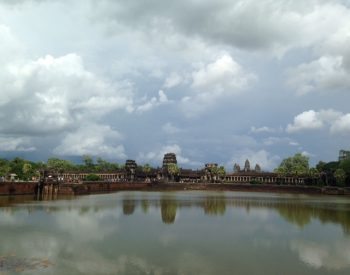
I knew Cambodia was drenched in historical riches, but I didn't expect to hear such telling tales about its temples.
When I booked my trip to Cambodia, (it was part of an extensive 14-day trip which also included a fabulous road trip from North to South Vietnam) I really didn’t expect to find what I found. Upon declaring my successful confirmation on Facebook, one of the more common tour tips I received by friends was to ensure that I saw Angkor Wat and Angkor Thom.
Angkor who? I shrugged. But as I do with all of my travels, I let it envelope me, educate me and enlighten me. And so my journey began.
Wat Phnom Daun Penh Temple in Pnom Penh
Her name was Lady Penh, founder of the capital of the country. Folklore dictates that in 1372, while fishing in a local river, Penh found four bronze Buddha statues and a stone of Vishnu tucked away in a Koki branch. She took her revered catch home and immediately instructed her villagers to create a hill northeast of her residence and with Koki wood build a shrine to house the Buddha statues she found as well as a shrine for the Vishnu image. The temple is Wat Phnom Daun Penh (“Phnom” means “hill” and “Daun” means “grandmother”) and it's currently known as “Wat Phnom”.

Photo Credit: Hina P. Ansari

Photo Credit: Hina P. Ansari
Approximately 90 feet high, Wat Phnom is a majestic site just a stone’s throw away from the bustling intersection of the city. It's an unexpected serene point in the madness that the country’s biggest metropolis that houses over two million people brings.
And this is where my temple-hopping journey began, with Lady Penh’s blessings.

Photo Credit: Hina P. Ansari
The Royal Palace in Pnom Penh
The grand complex of The Royal Palace is a site to be seen. Royal Palaces were erected and destroyed through Cambodia’s tumultuous history dating back to the early 800s. However under the French Protectorate Act of the mid 1800s, the current royal residence (which is completely operational and used as a residence by the current King) was built in 1863.

Photo Credit: Hina P. Ansari
Various buildings adorn the plush complex including numerous temples and mausoleums, both boasting the unique blend of design influences from Hinduism and Buddhism ideologies. Historically speaking, these two belief systems often battled it out (literally) by the country’s long line of Kingdoms during the ancient historical years. Now generations (and centuries) have passed with the end result being a beautiful blend of the two spiritual paths, which are fully evident in the various temples that anchor the neighbourhoods across Cambodia.
The regal colours of navy blue, emerald green and gold distinguish the entire Royal Palace. Various goddesses adorn the pointed corners of the rooftops of the buildings. The sharp angles replicate the shape of the arms and hands when in prayer.

Photo Credit: Hina P. Ansari

Photo Credit: Hina P. Ansari
Angkor Thom’s Bayon Temple in Siem Riep
After a short trip aboard a propeller plane, I landed in Siem Riep where Cambodia’s ancient city of Angkor Thom (which means "Great City") is located.
Established in the late 12th century by King Jayavarman VII, Angkor Thom was the last capital of the Khmer empire. It spans nine kilometers and includes various monuments preceding the King’s reign as well as those built during his time. The city housed close to 150,000 people.

Photo Credit: Hina P. Ansari
Marked by various entrances, the key entrance to Angkor Thom is the South Gate where much to my delight I was stuck in a traffic jam consisting of elephants, jeeps, cars and pedestrians. The bridge leading up to the entrance is lined with sculptures of 54 Devas (guardian gods) and 54 Asuras (demon guards) protecting Angkor Thom. All are seen pulling the tail of the revered Nagin (snake god) which some would say is in keeping with the revered Hindu story of the Churning Of The Ocean Of Milk.

Photo Credit: Hina P. Ansari

The total number equals that of the beads found in a round of Buddhist prayer beads.
The central temple is the Bayon, which was positioned as the official temple of the King. Jayavarman built this temple reflecting both Hindu and Buddhist beliefs. Architectural detail of this broad temple is buoyed by the various Buddhist faces that adorn the various columns and walkways of the temple.

Photo Credit: Hina P. Ansari
Inside, I am mesmerized by the endless intricate wall sculptures which depicted the every day life of the Khmer people. Mundane activities such as cooking, bathing, hunting (or being hunted) and battle scenes are so delightfully portrayed that it lends itself to the vast mosaic of storytelling that the temple provides.

Photo Credit: Hina P. Ansari

What's for dinner? According to this depiction it's barbecued fish.
Photo Credit: Hina P. Ansari
Angkor Wat Temple at Siem Riep
Angkor Wat literally means “City of Temples." Known as the largest religious monument in the world, it spans 163 hectares (just under a square mile) and was built by King Suryavarman II in early 12th century as a temple to honour the God Vishnu.
The name is heavily reliant on its Sanskrit lineage with “nokor” being the vernacular version of “Angkor." Nokor comes from the Sanskrit word “nagara." “Wat” is Khmer for “temple grounds” and is also derived from the Sanskrit word of “vata” which means “enclosure." This alone shows the brilliant blending of both cultures.

The majestic Angkor Wat.
Photo Credit: Hina P. Ansari
The walkway leading up to Angkor Wat.
Photo Credit: Hina P. Ansari
It took approximately 30 years to build this temple and just like the Angkor Thom, it shifted back and forth between Hinduism and Buddhism as places of worship. During Cambodia’s French colonization it was “rediscovered” and revitalization projects ensued. In 1992 it was declared a UNESCO World Heritage site and since then through various co-projects with countries from around the world (currently with Japan), the maintenance of the temple continues to flourish as well as being a bustling tourism magnet.
One of the many nooks found in Angkor Wat.
Photo Credit: Hina P. Ansari
Not only is the temple grand from the outside but when navigating through its maze of walkways, steps and terraces you see, once again, the intricate work of the interior. Similar to Angkor Thom, an elaborate wall sculpture spans all the way around the temple and it depicts the daily lives of the residents of the temple anchored by the magnificent retelling of Vishnu’s various battles.
Gods pulling on the tail of the Nagin depicting the Churning Of The Ocean Of Milk.
Photo Credit: Hina P. Ansari
The prominence of Angkor Wat to Cambodia is evidenced by its depiction on endless souvenirs as well as being prominently displayed in Cambodia’s flag.
Ta Prohm Temple at Angkor Wat
In short, this is the temple where Angelina Jolie filmed her film Laura Croft: Tomb Raider. It’s a huge tourist site and because Angelina adopted her first child, Maddox from Cambodia people love her here.
This temple doesn’t boast the grandiosity that Angkor Wat itself possesses, however the cinematic connection definitely adds to the allure of this specific site.
Ta Prohm Temple at Angkor Wat.
Photo Credit: Hina P. Ansari
What’s most interesting is the way the Banyan trees have erupted and basically wrapped themselves around the temple adding to the mystic vibe. Coincidentally enough, I discovered that this temple is part of a multi-year restoration project that the Cambodian government has with India. Honestly, though, I couldn’t really see any signs of “restoring” per say. However in some way I was glad to see it shine in its natural raw glory.
Ta Prohm Temple revitalizing project co-helmed by Cambodia and India.
Photo Credit: Hina P. Ansari

Angelina Jolie as Laura Croft filming on location at Ta Prohm Temple.
Photo Credit: www.jaimelamonde.com
Cambodia continues to keep me in its spell. Even months after my jaunt there. Among the many places where I’ve marked to revisit, Cambodia is definitely on that list. On a side note: amusing though was that although I haven’t seen Angelina’s film, a quip by another tourist (“Well I guess I need to see this Tomb Raider film now”) made me smile. In addition to discovering such incredible historical and architectural wonders in Cambodia, I’ve added another film to my Netflix list. And that folks, is what I call a win-win situation.
Special thanks to my personal guide Mr. Chanseng in Phnom Penh, and Mr. Phally in Siem Reap and of course Nikki at Indochina Odyssey Tours!
Main Image Photo Credit: Hina P. Ansari
Hina P. Ansari
Author
Hina P. Ansari is a graduate from The University of Western Ontario (London, Ontario). Since then she has carved a successful career in Canada's national fashion-publishing world as the Entertainment/Photo Editor at FLARE Magazine, Canada's national fashion magazine. She was the first South Asian in...



















































































































